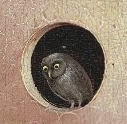








These are not scholarly reviews but indications of my own opinions on these books.

|
Bergman, Madeleine. Hieronymus Bosch and Alchemy. A study of the St Anthony Triptych. Almqvist and Winksell, Stockholm. 1979. Bergman initially discusses the image of St Anthony as reflected in the medieval Legenda Aurea (Legends of the Saints). Next she surveys the various modern interpretations of Bosch's Temptation of St Anthony. Her third chapter is a short summary of alchemical mysticism and imagery. In her final chapter she presents her alchemical reading of Bosch's Temptation of St Anthony, the Lisbon version. |
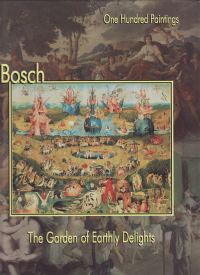
|
Zeri, Federico. Bosch. The Garden of Earthly Delights. NDE Publishing, 2000. A rather fine short survey of Bosch's paintings (not only the Garden of Earthly Delights). No grand theories or speculations, but a straightforward description of come of the main elements of his paintings. The books is well laid out and uses good graphics to point to important aspects of the paintings. Large format with large full page images. |
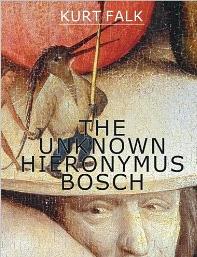
|
Falk, Kurt. The Unknown Hieronymous Bosch, Golden Stone 2008. Poor old Bosch ! This book by Kurt Falk The Unknown Hieronymus Bosch, issued in 2008, disgraces this great painter. How can an intelligent person like Kurt Falk be so unsympathetic to Bosch as a real living person. Falk is a believer in the turn of the century Austrian "clairvoyant" cultist Rudolf Steiner. Steiner claimed to have a spiritual perception way above all other people, so he could not be criticised. He presented his opinions as spiritual perceptions with which one could not quibble, after all we mere mortals could not see into the inner workings of the spiritual world as he could. Steiner's nonsense has survived him and there is still a flourishing group of people who totally and unquestionably believe in his pronouncements. This is all very well when these anthroposophists stay in their own limited world, who cares if some people need to believe in some system of ideas, that is their existential problem, but it is annoying when they push their nonsense onto real people such as Hieronymus Bosch. Falk throws his barrage of esoteric theories at Bosch's paintings, presenting our painter as some kind of initiate, with some task to enlighten humanity. He draws on earlier Bosch commentators, Fraenger and Wertheim-Aymes and wheels out a mass of esoteric ideas of which Bosch knew nothing, 'Kamaloca', the planetary periods invented by Steiner in his book Occult Science, 'Rosicrucians' in 1505 over a hundred years before the first appearance of the idea in the early 1610s, Ichthus worlds (whatever they are), three streams of mankind, planetary incarnations of the earth, a formation of a new earth karma. All these things and many more have nothing to do with Bosch. He never heard of them. They are inventions of 20th century esotericism and Steiner's imagination. Falk read this back into Bosch's work. Poor old Bosch is buried in esoteric gobbledegook. I feel sorry for Bosch. But I feel angry that an intelligent person is so obsessed with such esoteric nonsense that he needs to vent this on one of the greatest of early Netherlandish painters. Nice pictures though. One could always cut them out and throw the useless text away. |
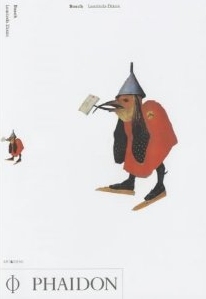
|
Dixon, Laurinda. Bosch. Phaidon, 2003. As someone with a deep knowledge of alchemical symbolism I am open to an alchemical interpretation. Nothing would give me greater delight than to bring Hieronymous Bosch into the alchemical tradition. To unite these two major interests of mine would be wonderful, but I have to remain honest to what I see and I just cannot find any alchemy in Bosch's paintings. 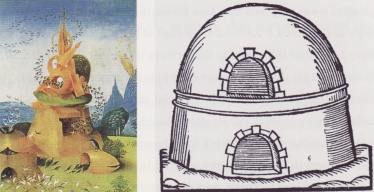 One has to retain historical context otherwise ones view becomes totally subjective and worthless. Bosch lived before the phase of alchemical printing, so he could only have been exposed to a few alchemical manuscripts which had emblematic imagery. Linking his depictions to images from engravings and woodcuts from a century later seems worthless to me. An example of this can be seen on p246 of Laurinda Dixon's book where she parallels one of the towers from left panel of the painting with a woodcut from Libavius from 1606 (a century later). Her commentary illustrates her way of thinking about these matters, indicating that in the image shown "...Bosch illustrates the cleansing of impure gases and the circular rise and fall of condensed vapours into liquid, as described in many alchemical texts. Furthermore, the hut-shaped hillock through which the white birds enter at the bottom left corresponds in shape to a type of rounded furnace ... that appeared in manuals throughout the seventeenth century." This appears to me as a kind of muddled thinking, looking for alchemical parallels where none exist, seeing the painting through an alchemical telescope. To me it is an entirely unconvincing book, and hopefully will eventually be reduced to a mere footnote in Bosch studies. Currently, as few people have an understanding of alchemical symbolism, many recent books uncritically accept the alchemical interpretation and quote Dixon as their source.
One has to retain historical context otherwise ones view becomes totally subjective and worthless. Bosch lived before the phase of alchemical printing, so he could only have been exposed to a few alchemical manuscripts which had emblematic imagery. Linking his depictions to images from engravings and woodcuts from a century later seems worthless to me. An example of this can be seen on p246 of Laurinda Dixon's book where she parallels one of the towers from left panel of the painting with a woodcut from Libavius from 1606 (a century later). Her commentary illustrates her way of thinking about these matters, indicating that in the image shown "...Bosch illustrates the cleansing of impure gases and the circular rise and fall of condensed vapours into liquid, as described in many alchemical texts. Furthermore, the hut-shaped hillock through which the white birds enter at the bottom left corresponds in shape to a type of rounded furnace ... that appeared in manuals throughout the seventeenth century." This appears to me as a kind of muddled thinking, looking for alchemical parallels where none exist, seeing the painting through an alchemical telescope. To me it is an entirely unconvincing book, and hopefully will eventually be reduced to a mere footnote in Bosch studies. Currently, as few people have an understanding of alchemical symbolism, many recent books uncritically accept the alchemical interpretation and quote Dixon as their source.
|
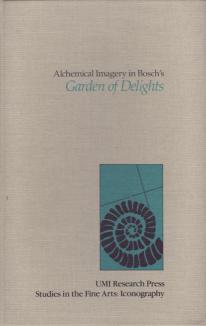
|
Dixon, Laurinda S. Alchemical Imagery in Bosch's Garden of Delights. UMI Research Press, 1981. Laurinda Dixon's Ph.D. Thesis. |
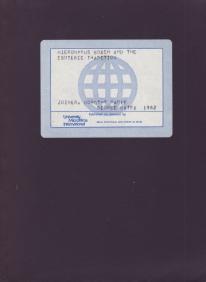
|
Joiner, Dorothy Marie. Hieronymus Bosch and the Esoteric Tradition. 1982. Dorothy Joiner's Ph.D. dissertation presented to Emory University. Essentially an iconographic study of the Lisbon Temptation of Saint Anthony. Joiner seems attached to seeing Bosch's work as influenced by a hermetic alchemical tradition. She also often sees his imagery as dream like and resorts to a Jungian interpretation in places. |

|
Beagle, Peter S. The Garden of Earthly Delights, Secker and Warburg, 1982. Peter Beagle is a novelist and screenwriter. This book is his reaction to and attempt to grasp the meaning of The Garden of Earthly Delights. It is essentially his experiences and insights into the painting, rather than some contrived interpretation. He does not resort to wild theorising, but perhaps tends to accept too readily the theses of writers such as Fraenger. |

|
Rowlands, John. The Garden of Earthly Delights. Hieronymus Bosch. Phaidon, 1979. A full sized reproduction of the complete painting, printed in a large format book. Short introduction by Rowlands. The colour reproductions are good and enable one to see all the detail, though they were made before the restoration of the work. As the whole painting is reproduced, this book is a excellent way to become familiar with all the little details that cannot be seen in full page illustrations, even in large books. |
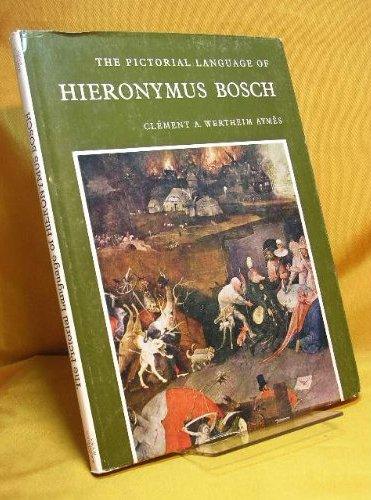
|
Wertheim Aymes, Clement A. The Pictorial Language of Hieronymus Bosch. New Knowledge Books, 1975. Wertheim Aymes like Kurt Falk is a follower of Rudolf Steiner. This colours all his interpretations and makes this book almost worthless to anyone wanting to study Bosch. It will only be significant to those with sympathies towards the anthroposophists. Aymes deals particularly with the Temptation of St Anthony but touches on some other works. |

|
Muller, Joseph-Emile. Bosch. Bourne End, Bucks. Spurbooks, [1976]. Small format book with short introduction and 94 pages of colour plates. |

|
Schwartz, Gary. First Impressions. Hieronymous Bosch. Harry N. Abrams Inc., New York, 1997. The author presents a sensitive survey Bosch's paintings and the world in which he lived and worked. He adopts a sceptical view of the various interpretations and studies by art historians that he has read, summarising their ideas but not becoming seduced by them. |

|
Campbell, W. John. The Essential Hieronymus Bosch. Wonderland Press, Harry N. Abrams Inc., New York, 2000. Straightforward account of Bosch's life with simple analyses of almost all his paintings. Little theorising, or references to the various interpretations or theories. |

|
Copplestone, Trewin. The Life and Works of Hieronymus Bosch. Paragon, 1995. |

|
Myers, Marshall Neal and Dynes, Wyne. Hieronymus Bosch and the Canticle of Isaiah. Cabirion Press, New York, 1987. |

|
Larsen, Erik. Hieronymus Bosch. Master Artist Library. The Compete Paintings by the Visionary Master. Smithmark, New York, 1998. |

|
Bertrand, José Antonio. La Alquimia en el Bosco, Durero y otros pintores del Renacimiento, Barcelona, 1989. Bertrand's approach is merely suggestive, as he finds almost any round object to be an athanor. He also identifies one image as an hermaphrodite, when it clearly is not, and another creature as an alchemical dragon. He extends this to Durer and other artworks of the period, but this is again unconvincing. |





